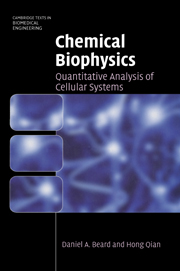Book contents
- Frontmatter
- Contents
- Preface
- Introduction
- Part I Background material
- Part II Analysis and modeling of biochemical systems
- Part III Special topics
- 8 Spatially distributed systems and reaction–diffusion modeling
- 9 Constraint-based analysis of biochemical systems
- 10 Biomacromolecular structure and molecular association
- 11 Stochastic biochemical systems and the chemical master equation
- 12 Appendix: the statistical basis of thermodynamics
- Bibliography
- Index
10 - Biomacromolecular structure and molecular association
Published online by Cambridge University Press: 05 June 2012
- Frontmatter
- Contents
- Preface
- Introduction
- Part I Background material
- Part II Analysis and modeling of biochemical systems
- Part III Special topics
- 8 Spatially distributed systems and reaction–diffusion modeling
- 9 Constraint-based analysis of biochemical systems
- 10 Biomacromolecular structure and molecular association
- 11 Stochastic biochemical systems and the chemical master equation
- 12 Appendix: the statistical basis of thermodynamics
- Bibliography
- Index
Summary
Overview
The theories of chemical kinetics and thermodynamics – largely the theoretical foundation of this book – are concerned primarily with describing how distinct molecular states are distributed temporally and among ensembles of molecules. Based on these theories, previous chapters have developed mathematical models of biochemical systems that account for molecular state changes that include chemical reactions, conformational changes, and non-covalent binding interactions, with little attention paid to the underlying structural details. Yet there is much to be learned from examining the structural basis of biomolecular states and functions. After all, structure and function are inseparable.
In fact, a tremendous amount of information is available on the structures of biological macromolecules; descriptions of structures of proteins and nucleic acids make up major portions of modern textbooks in biochemistry and molecular biology. The Protein Data Bank and the Nucleic Acid Database are online archives that contain sequence and structural data on thousands of specific molecules and complexes of molecules. This structural information comes from in vitro experiments, with structures inferred from the x-ray diffraction patterns of crystallized molecules, spectroscopic measurements using multi-dimensional nuclear magnetic resonance, and a host of other methodologies.
Even though in vitro experiments necessarily remove biomolecules from the cellular environment, the structures and dynamics of individual macromolecules provide insights to their biological functions.
- Type
- Chapter
- Information
- Chemical BiophysicsQuantitative Analysis of Cellular Systems, pp. 240 - 260Publisher: Cambridge University PressPrint publication year: 2008



